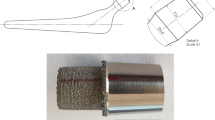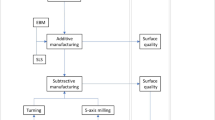Abstract
Prosthesis production for hips, knees, and other human body elements, including dental implants and spine screws, requires eliminating any risk of material damage or contamination. Five-axis milling is the most suitable technique to manufacture tailor-made prostheses for different personalized sizes with affordable costs. Human life expectancy is growing, so the demand of a higher prosthesis lifecycle and manufacturing optimization is a current necessity. In this work, a robust five-axis milling process using cryogenic CO2 as coolant fluid is presented and applied to a Ti6Al4V knee implant. Ti6Al4V (grade 5 and grade 23) alloys are very difficult to cut without lubri-cooling using oil emulsion coolant; however, this emulsion implies risks from introducing little oil drops entrapped in surface roughness valleys, hampering the cleaning process before patient’s surgery. CO2 reduces this risk uncertainty, making machining operations more feasible and suitable regarding environmental sustainability. In terms of feasibility, the surface finishing, roughness, and residual stresses was analysed, obtaining a standard of IT4-IT5, N4 and compressive stresses, respectively. Virtual simulation of machining is also a key in five-axis to make a more robust industrial process.














Similar content being viewed by others
References
Orthopedic Information | Demo.eOrthopod.com. https://eorthopod.com/. Accessed 17 Dec 2020
Flanders (2007) Medical Devices in the USA
Nieto Díaz de los Bernardos MI (2015) Clínica, epidemiología y pronóstico de la infección de prótesis articular: estudio multicéntrico. Universidad de Sevilla
(2018) Prácticas y tendencias en el proceso de atención de las artoplastias primarias totales de rodilla y cadera
Denkena B, Köhler J, Turger A, et al. (2013) Manufacturing conditioned wear of all-ceramic knee prostheses. In: Procedia CIRP.
Hilerio I, Mathia T, Alepee C (2004) 3D measurements of the knee prosthesis surfaces applied in optimizing of manufacturing process. In: Wear.
4 types of knee implants - Harvard Health. https://www.health.harvard.edu/pain/4-types-of-knee-implants. Accessed 17 Dec 2020
Jaime duboy U (2014) Prótesis total y unicompartimental en el manejo de artrosis grave de rodilla. Rev Médica Clínica Las Condes 25:780–785. https://doi.org/10.1016/s0716-8640(14)70108-7
Gök A, Gök K, Bilgin MB, Alkan MA (2017) Effects of cutting parameters and tool-path strategies on tool acceleration in ball-end milling. Mater Tehnol 51:957–965. https://doi.org/10.17222/mit.2017.039
Gok A, Gologlu C, Demirci HI (2013) Cutting parameter and tool path style effects on cutting force and tool deflection in machining of convex and concave inclined surfaces. Int J Adv Manuf Technol 69:1063–1078. https://doi.org/10.1007/s00170-013-5075-x
Markopoulos AP, Galanis NI, Karkalos NE, Manolakos DE (2018) Precision CNC machining of femoral component of knee implant: a case study. Machines 6. https://doi.org/10.3390/MACHINES6010010
Azzam N, Chaves-Jacob J, Boukebbab S, Linares JM (2014) Adaptation of machining toolpath to distorted geometries: application to remove a constant thickness on rough casting prosthesis. Int J Adv Manuf Technol 72. https://doi.org/10.1007/s00170-014-5738-2
Kourra N, Warnett JM, Attridge A, Dibling G, McLoughlin J, Muirhead-Allwood S, King R, Williams MA (2018) Computed tomography metrological examination of additive manufactured acetabular hip prosthesis cups. Addit Manuf 22. https://doi.org/10.1016/j.addma.2018.04.033
Gök A, Demirci HI, Gök K (2016) Determination of experimental, analytical, and numerical values of tool deflection at ball end milling of inclined surfaces. Proc Inst Mech Eng Part E J Process Mech Eng 230:111–119. https://doi.org/10.1177/0954408914540633
Nevelos J (2004) Surface engineering of prosthetic knee components. Knee 11:163–167
Phanphet S, Dechjarern S, Jomjanyong S (2017) Above-knee prosthesis design based on fatigue life using finite element method and design of experiment. Med Eng Phys 43. https://doi.org/10.1016/j.medengphy.2017.01.001
Saptaji K, Gebremariam MA, Azhari MABM (2018) Machining of biocompatible materials: a review. Int J Adv Manuf Technol 97:2255–2292. https://doi.org/10.1007/s00170-018-1973-2
Peterson CD, Hillberry BM, Heck DA (1988) Component wear of total knee prostheses using Ti-6Al-4V, titanium nitride coated Ti-6Al-4V, and cobalt-chromium-molybdenum femoral components. J Biomed Mater Res 22. https://doi.org/10.1002/jbm.820221005
Beranoagirre A, Olvera D, López De Lacalle LN (2012) Milling of gamma titanium-aluminum alloys. Int J Adv Manuf Technol 62:83–88. https://doi.org/10.1007/s00170-011-3812-6
Sadik MI, Isakson S, Malakizadi A, Nyborg L (2016) Influence of Coolant Flow Rate on Tool Life and Wear Development in Cryogenic and Wet Milling of Ti-6Al-4V. In: Procedia CIRP
Pereira O, Rodríguez A, Fernández-Abia AI, Barreiro J, López de Lacalle LN (2016) Cryogenic and minimum quantity lubrication for an eco-efficiency turning of AISI 304. J Clean Prod 139:440–449. https://doi.org/10.1016/j.jclepro.2016.08.030
Sharma J, Sidhu BS (2014) Investigation of effects of dry and near dry machining on AISI D2 steel using vegetable oil. J Clean Prod 66:619–623. https://doi.org/10.1016/j.jclepro.2013.11.042
Shashidhara YM, Jayaram SR (2010) Vegetable oils as a potential cutting fluid-An evolution. Tribol Int 43:1073–1081. https://doi.org/10.1016/j.triboint.2009.12.065
Park KH, Olortegui-Yume J, Yoon MC, Kwon P (2010) A study on droplets and their distribution for minimum quantity lubrication (MQL). Int J Mach Tools Manuf 50:824–833. https://doi.org/10.1016/j.ijmachtools.2010.05.001
Mang T, Freiler C, Hörner D (2017) Metalworking Fluids. In: Lubricants and Lubrication. Wiley-VCH Verlag GmbH & Co. KGaA, Weinheim, Germany, pp 491–638
Pereira O, Martín-Alfonso JE, Rodríguez A, Calleja A, Fernández-Valdivielso A, López de Lacalle LN (2017) Sustainability analysis of lubricant oils for minimum quantity lubrication based on their tribo-rheological performance. J Clean Prod 164. https://doi.org/10.1016/j.jclepro.2017.07.078
Khanna N, Shah P, Chetan (2020) Comparative analysis of dry, flood, MQL and cryogenic CO2 techniques during the machining of 15-5-PH SS alloy. Tribol Int 146:106196. https://doi.org/10.1016/j.triboint.2020.106196
Pereira O, Rodríguez A, Barreiro J, Fernández-Abia AI, de Lacalle LNL (2017) Nozzle design for combined use of MQL and cryogenic gas in machining. Int J Precis Eng Manuf - Green Technol 4. https://doi.org/10.1007/s40684-017-0012-3
Klocke F, Sangermann H, Krämer A, Lung D (2011) Influence of a High-Pressure Lubricoolant Supply on Thermo-Mechanical Tool Load and Tool Wear Behaviour in the Turning of Aerospace Materials. Proc Inst Mech Eng Part B J Eng Manuf 225:52–61. https://doi.org/10.1177/09544054JEM2082
Pittalà GM (2018) A study of the effect of CO2 cryogenic coolant in end milling of Ti-6Al-4V. In: Procedia CIRP
CO2 Cleaning Technology - Dry, Waterless & Automated. https://coolclean.com/CO2-cleaning/. Accessed 17 Dec 2020
Columbus® Total Knee System. https://www.bbraun.com/en/products/b0/columbus-total-kneesystem.html. Accessed 17 Dec 2020
Columbus® Revision Total Knee System. https://www.bbraun.com/en/products/b0/columbus-revisiontotalkneesystem.html. Accessed 17 Dec 2020
ISO-Standards. (2013) DS/EN ISO 286-1 Geometrical product specifications (GPS) – ISO code system for tolerances on linear sizes – Part 1: Basis of tolerances, deviations and fits
ISO-Standards. (2006) DS/EN ISO 4288 Geometrical product specifications (GPS) – Surface texture: Profile method – Rules and procedures for the assessment of surface texture. In: DS-HANDBOG 114.5:2006 Geometrical product spefifications (GPS)
ISO-Standards. (2002) DS/EN ISO 1302: Geometrical Product Specifications (GPS) — Indication of surface texture in technical product documentation. Iso 2002:54
ASTM E837-13a (2013) Standard Test Method for Determining Residual Stresses by the Hole-Drilling Strain-Gage Method. Stand. Test Method:E837–E13a
Thakur A, Gangopadhyay S (2016) State-of-the-art in surface integrity in machining of nickel-based super alloys. Int J Mach Tools Manuf 100:25–54
Acknowledgements
The authors would also like to thank the vice-rector of innovation, social commitment, and cultural action of the UPV/EHU (Bizialab programme of the Basque Government), the UPV/EHU itself for the financial aid for the pre-doctoral grants PIF 19/161, also to MACROPISTAS (PID2019-104488RB-I00) of the Spanish Ministry of Economy and Competitiveness and ELKARTEK program, from the Department of the Basque Government related to the project with the acronym COPTER.
Data and materials availability
Not applicable. No data relating to people or animals have been recorded during this work.
Funding
The authors wish to thank the University of the Basque Country for the support that enabled this study to be carried out.
Author information
Authors and Affiliations
Contributions
“Conceptualization, A.C. and N.L.; methodology, H.G.; software, G.M.; validation, A.J., O.P. and G.G.; writing—review and editing, H.G.; project administration, N.L.; funding acquisition, N.L. All authors have read and agreed to the published version of the manuscript.”
Corresponding author
Ethics declarations
Ethics approval and consent to participate
Not applicable. Since this study has not worked with either humans or animals. Not applicable. This paper develops the process of manufacturing a knee prosthesis. Since this prosthesis has not been transplanted to any person, no consent for publication has been required from any person.
Consent for publication
Not applicable. It has not been necessary to ask for the consent of any person, since the work has been focused on the manufacture of a knee prosthesis, and not on the process of implantation in a person.
Conflict of interest
“The authors declare no conflict of interest.” “The funders had no role in the design of the study; in the collection, analyses, or interpretation of data; in the writing of the manuscript, or in the decision to publish the results”.
Additional information
Publisher’s note
Springer Nature remains neutral with regard to jurisdictional claims in published maps and institutional affiliations.
Highlights
- CO2 showed good results as coolant in Ti6al4V and reduces a source of oil contamination.
- Reductions in time would be derived from virtual engineering and simulation.
- Reduction in time and a sound production process is the only way to manufacture adapted or Taylor-made prostheses in short times.
- The full process is explained, giving clues for further works.
- Few works about knee prostheses manufacturing are, at least less than hip ones.
Rights and permissions
About this article
Cite this article
Gómez-Escudero, G., Jimeno Beitia, A., Martínez de Pissón Caruncho, G. et al. A reliable clean process for five-axis milling of knee prostheses. Int J Adv Manuf Technol 115, 1605–1620 (2021). https://doi.org/10.1007/s00170-021-07220-1
Received:
Accepted:
Published:
Issue Date:
DOI: https://doi.org/10.1007/s00170-021-07220-1




